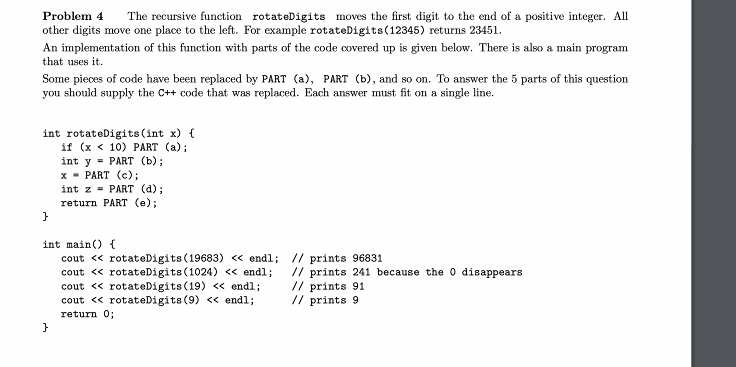Problem 4 The recursive function rotateDigits moves the first digit to the end of a positive integer. All other digits move one place to the left. For example rotateD1gits(12345) returns 23451. An implementation of this function with parts of the code covered up is given below. There is also a main program that uses it. Some pieces of code have been replaced by PART (a), PART (b), and so on. To answer the 5 parts of this question you should supply the C++ code that was replaced. Each answer must fit on a single line. 80
Problem 4 The recursive function rotateDigits moves the first digit to the end of a positive integer. All other digits move one place to the left. For example rotateD1gits(12345) returns 23451. An implementation of this function with parts of the code covered up is given below. There is also a main program that uses it. Some pieces of code have been replaced by PART (a), PART (b), and so on. To answer the 5 parts of this question you should supply the C++ code that was replaced. Each answer must fit on a single line. 80
C++ Programming: From Problem Analysis to Program Design
8th Edition
ISBN:9781337102087
Author:D. S. Malik
Publisher:D. S. Malik
Chapter15: Recursion
Section: Chapter Questions
Problem 8SA
Related questions
Question

Transcribed Image Text:Problem 4
The recursive function rotateDigits moves the first digit to the end of a positive integer. All
other digits move one place to the left. For example rotateDigits(12345) returns 23451.
An implementation of this function with parts of the code covered up is given below. There is also a main program
that uses it.
Some pieces of code have been replaced by PART (a), PART (b), and so on. To answer the 5 parts of this question
you should supply the C++ code that was replaced. Each answer must fit on a single line.
int rotateDigits (int x) {
if (x < 10) PART (a);
int y = PART (b);
х - PART (с);
int z = PART (d);
return PART (e);
int main() {
cout « rotateDigits (19683) « endl; // prints 96831
cout « rotateDigits (1024) <« endl;
cout « rotateDigits (19) <« endl;
cout « rotateDigits (9) <« endl;
// prints 241 because the o disappears
// prints 91
// prints 9
return 0;
Expert Solution
This question has been solved!
Explore an expertly crafted, step-by-step solution for a thorough understanding of key concepts.
This is a popular solution!
Trending now
This is a popular solution!
Step by step
Solved in 3 steps with 1 images

Knowledge Booster
Learn more about
Need a deep-dive on the concept behind this application? Look no further. Learn more about this topic, computer-science and related others by exploring similar questions and additional content below.Recommended textbooks for you

C++ Programming: From Problem Analysis to Program…
Computer Science
ISBN:
9781337102087
Author:
D. S. Malik
Publisher:
Cengage Learning

C++ Programming: From Problem Analysis to Program…
Computer Science
ISBN:
9781337102087
Author:
D. S. Malik
Publisher:
Cengage Learning